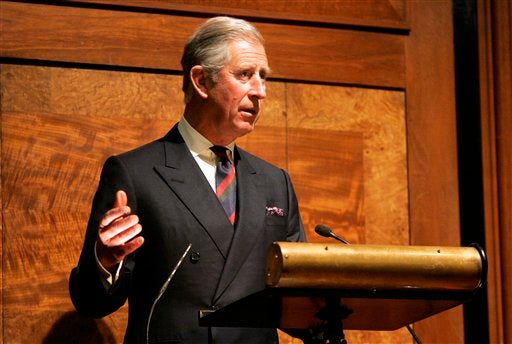Architects' Prince Charles boycott fizzles out

There were no empty seats in the Royal Institute of British Architects auditorium last night as a planned boycott of Prince Charles' speech faded away.
Although some prominent architects did not attend to protest Charles' harsh views of modern architecture, and his opposition to a steel-and-glass tower development at an old Army barracks in central London, plenty of institute members were happy to claim the extra tickets.
Charles, who has for years condemned modern architecture as a scourge destroying Britain's heritage, seemed relieved.
"It is a wonder to find the hall seemingly fully occupied," he said, before beginning a passionate speech denouncing the ways modernism and the quest for profits have separated man from the harmony of nature.
His keynote speech marking the 175th anniversary of the founding of the prestigious British architecture group came 25 years after he first denounced modernism before the same body.
On Tuesday, he described how as a teenager in the 1960s he watched towns, cities and the English countryside be destroyed by modernism. He said England was turned into a soulless, impersonal place in the name of progress.
"The loss was immense, incalculable, an insane reformation that, I believe, went too far, particularly when so much could have been restored, converted, or reused with a bit of extra thought," he said in a quiet, forceful tone.
The response from the audience was polite, although one woman shouted "Abolish the monarchy" as Charles and his wife Camilla left the auditorium.
One architect stood up and shouted "No" in reply.
The architects' reaction to the speech seemed mixed. Some said the prince had been an effective advocate for the need to fight global warming; others said he seemed to be looking to the past.
"I thought it was inspirational," said Manchester architect Neal Charlton. "It's interesting the way he ties traditional aspects to sustainability. It's an olive branch, a way forward on reducing emissions and all those key things."
But architect Andrew Ellis said the speech was a bit of a dud and broke no new ground.
"I wasn't overly impressed," he said.
Peter Gibbs-Kennet, chief editor of the Journal of Architecture, said Charles' talk showed the importance the heir to the throne attaches to architecture.
"That can only be good," he said. "His speech 25 years ago led to more interest in architecture. He's done a lot of good."
At the start of the speech, Charles laughed off his many critics, saying he wouldn't be around to thwart contemporary architects too much longer.
"In another twenty-five years I shall very likely have shuffled off this mortal coil and so those of you who do worry about my inconvenient interferences won't have to do so any more — unless, of course, they prove to be hereditary," he said.
The prince's detractors said they were angry about Charles' criticism of modern architecture and his opposition to a major project to build a steel-and-glass tower at the Chelsea army barracks.
They were particularly upset about media reports indicating the prince contacted the Qatari royal family, the project's main investors, to try and steer them away from the modernist design planned for the site in London's exclusive Chelsea neighborhood.
Nine architects including Will Alsop, Piers Gough and Tony Fretton signed a public letter urging the boycott.
Alsop said Charles was entitled to his views, but should not try to subvert the planning process of a project by using his personal power and influence.
"This site came onto the market years ago," Alsop said. "You don't suddenly do it by having one royal family whisper to another royal family in Qatar when people have already spent millions of dollars preparing this scheme. It's a misuse of his very powerful position."
Architecture luminaries Norman Foster and Frank Gehry and others called for Charles to stay on the sidelines.
Charles did no such thing Tuesday, calling on architects to look to nature and history for inspiration rather than relying on abstractions. Still, he refrained from attacking individual architects or specific projects and called for the architects to work with his foundation to come up with ways to develop sustainable buildings that could reduce carbon emissions and fight carbon change.
Historically, British royals have had a strong impact on architectural trends.
Henry VIII and other monarchs determined what building styles were used in the 16th and 17th centuries, and Queen Elizabeth I used her influence to have her friends build showcase houses where she could be entertained, according to Malcolm Airs, president of the Society of Architectural Historians.
"The royals have served as patrons, and patrons shape architectural taste," he said. "There's a long tradition of monarchs having a great influence on architecture, but this changed in the 20th century because Queen Elizabeth II and her father King George VI were not particularly interested."
But architects said his interference in the Chelsea barracks redevelopment project meant he should not be speaking at all.
The project he opposes envisions steel and glass towers designed by architect Richard Rogers built next to the classical Royal Hospital Chelsea. The hospital building was designed by 17th-century architect Christopher Wren, best known for St. Paul's Cathedral in central London.
The 13-acre (5.3-hectare) development would include a hotel and 552 apartments. It is a mega-project by any standard — the site alone cost 959 million pounds ($1.44 billion).
Subscribe to Independent Premium to bookmark this article
Want to bookmark your favourite articles and stories to read or reference later? Start your Independent Premium subscription today.

Join our commenting forum
Join thought-provoking conversations, follow other Independent readers and see their replies